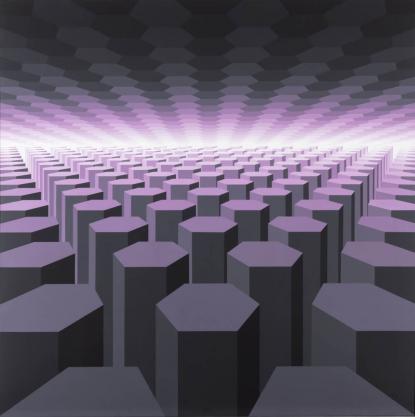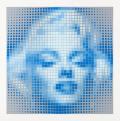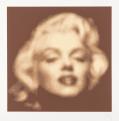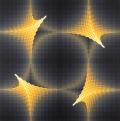2024. May 4. Saturday
Baranya County Museum Authority - Modern Hungarian Gallery II. - Pécs
|
|
Address: 7621, Pécs Papnövelde u. 5.
Phone number: (72) 514-040
E-mail: jpm@jpm.hu
Opening hours: Tue-Sun 10-18
|
The exhibition has closed for visitors.
2015.05.22. - 2015.09.20.
Ticket prices
|
Individual ticket for adults
|
2000 HUF
|
|
|
Individual ticket for students
|
1000 HUF
|
|
|
Individual ticket for pensioners
|
1000 HUF
|
He was born as Yvaral Jean-Pierre Vásárhelyi on 25 January 1934, in Paris. The art of his father, Victor Vasarely influenced him immensely. Yvaral Jean-Pierre Vásárhelyi's art was also inspired by the spirit of op-art art, at the same time he came into contact with Pop Art with its freedom.

In 1950 1953 he studied graphics and advertisement at the École des Arts Appliqués. After graduating, he was involved in advertising design and was head of a studio until 1964. From 1958 he regularly exhibited at the Galérie Denise René. In 1960 with many other artists - Julio Le Parc, François Morellet, Francisco Sobrino, Horacio Garcia Rossi and Joel Stein - founded the art group Groupe de Recherche d’Art Visuel aiming at developing a coherent abstract visual language consisting of simple geometric elements.
Until 1968, he primarily made black-and-white reliefs of plexiglas, metal plates, plastic and rubber based on optical effect, which, depending on the viewer's point of view, provided a changing spectacle. In 1969 he returned to painting. These works starting in 1975, like images his "numeric" ones consisted of simple geometric elements and shapes, redesigned in accordance with strict structures. Later, he worked mostly using computer, did digitally edited and manipulated images, although in all cases he painted the final image by hand.
Since the early '80s his numerical paintings portrayed mainly well- known personalities(eg.: Mona Lisa, J.S. Bach, Lincoln, Marilyn Monroe, Salvador Dalí). By enlarging the photos to an extra-large size, the digital pixels themselves are the image makers. The movement of spectators once again play an important role. Distancing from the image, the facial features gradually draw out of the geometric abstract sight.
Yvaral was also a successful stage designer in addition to creating several works linked to famous buildings, in cooperation with Vasarely and individually, too. One of the examples is the facade for the RTL Building in Paris, the Mona Lisa pediment, in the rue du Louvre, the Hommage á Blaise Pascal in the IBM Headquarters, in Vendôme Square, The Beverly Wilshire Hotel in Los Angeles, the Hôtel Negresco in Nizza, or the Steinkjeri Town Hall in Oslo, or, probably the best known of all is the diamond shape symbol for Renault.
Yvaral died at the age of 68, on 2 August, 2002 in Paris.
In 1974 Victor Vasarely bestowed on our collection, together with many contemporary works, a painting by Yvaral and 10 serigraphs. The selection to be displayed in Pécs was selected from the Vasarely Foundation Aix-en-Provence collection, through the help of Pierre Vasarely, Chairman of the Foundation – Yvaral's son. It is the first time the art of Yvaral Jean-Pierre Vásárhelyi will be shown in Hungary.

In 1950 1953 he studied graphics and advertisement at the École des Arts Appliqués. After graduating, he was involved in advertising design and was head of a studio until 1964. From 1958 he regularly exhibited at the Galérie Denise René. In 1960 with many other artists - Julio Le Parc, François Morellet, Francisco Sobrino, Horacio Garcia Rossi and Joel Stein - founded the art group Groupe de Recherche d’Art Visuel aiming at developing a coherent abstract visual language consisting of simple geometric elements.
Until 1968, he primarily made black-and-white reliefs of plexiglas, metal plates, plastic and rubber based on optical effect, which, depending on the viewer's point of view, provided a changing spectacle. In 1969 he returned to painting. These works starting in 1975, like images his "numeric" ones consisted of simple geometric elements and shapes, redesigned in accordance with strict structures. Later, he worked mostly using computer, did digitally edited and manipulated images, although in all cases he painted the final image by hand.
Since the early '80s his numerical paintings portrayed mainly well- known personalities(eg.: Mona Lisa, J.S. Bach, Lincoln, Marilyn Monroe, Salvador Dalí). By enlarging the photos to an extra-large size, the digital pixels themselves are the image makers. The movement of spectators once again play an important role. Distancing from the image, the facial features gradually draw out of the geometric abstract sight.
Yvaral was also a successful stage designer in addition to creating several works linked to famous buildings, in cooperation with Vasarely and individually, too. One of the examples is the facade for the RTL Building in Paris, the Mona Lisa pediment, in the rue du Louvre, the Hommage á Blaise Pascal in the IBM Headquarters, in Vendôme Square, The Beverly Wilshire Hotel in Los Angeles, the Hôtel Negresco in Nizza, or the Steinkjeri Town Hall in Oslo, or, probably the best known of all is the diamond shape symbol for Renault.
Yvaral died at the age of 68, on 2 August, 2002 in Paris.
In 1974 Victor Vasarely bestowed on our collection, together with many contemporary works, a painting by Yvaral and 10 serigraphs. The selection to be displayed in Pécs was selected from the Vasarely Foundation Aix-en-Provence collection, through the help of Pierre Vasarely, Chairman of the Foundation – Yvaral's son. It is the first time the art of Yvaral Jean-Pierre Vásárhelyi will be shown in Hungary.




